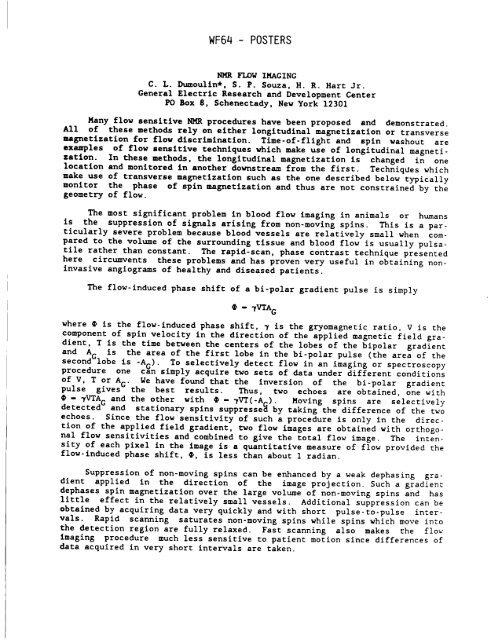th - 1987 - 51st ENC Conference
th - 1987 - 51st ENC Conference
th - 1987 - 51st ENC Conference
Create successful ePaper yourself
Turn your PDF publications into a flip-book with our unique Google optimized e-Paper software.
WF64- POSTERS<br />
NMR FLOW IMAGING<br />
C. L. Dumoulln*, S. P. Souza, H. R. Hart Jr.<br />
General Electric Research and Development Center<br />
PO gox 8, Schenectady, New York 12301<br />
Many flow sensitive NMR procedures have been proposed and demonstrated.<br />
All of <strong>th</strong>ese me<strong>th</strong>ods rely on ei<strong>th</strong>er longitudinal magnetization or transverse<br />
magnetization for flow discrimination. Time-of-flight and spin washout are<br />
examples of flow sensitive techniques which make use of longitudinal magneti-<br />
zation. In <strong>th</strong>ese me<strong>th</strong>ods, <strong>th</strong>e longitudinal magnetization is changed in one<br />
location and monitored in ano<strong>th</strong>er downstream from <strong>th</strong>e first. Techniqdes which<br />
make use of transverse magnetization such as <strong>th</strong>e one described below typically<br />
monitor <strong>th</strong>e phase of spin magnetization and <strong>th</strong>us are not constrained by <strong>th</strong>e<br />
geometry of flow.<br />
The most significant problem in blood flow imaging in animals or humans<br />
is <strong>th</strong>e suppression of signals arising from non-moving spins. This is a par-<br />
ticularly severe problem because blood vessels are relatively small when com-<br />
pared to <strong>th</strong>e volume of <strong>th</strong>e surrounding tissue and blood flow is usually pulsa-<br />
tile ra<strong>th</strong>er <strong>th</strong>an constant. The rapid-scan, phase contrast technique presented<br />
here circumvents <strong>th</strong>ese problems and has proven very useful in obtaining non-<br />
invasive angiograms of heal<strong>th</strong>y and diseased patients.<br />
The flow-induced phase shift of a bi-polar gradient pulse is simply<br />
- vVTA G<br />
where ~ is <strong>th</strong>e flow-induced phase shift, 7 is <strong>th</strong>e gryomagnetic ratio, V is <strong>th</strong>e<br />
component of spin velocity in <strong>th</strong>e direction of <strong>th</strong>e applied magnetic field gra-<br />
dient, T is <strong>th</strong>e time between <strong>th</strong>e centers of <strong>th</strong>e lobes of <strong>th</strong>e bipolar gradient<br />
and A G is <strong>th</strong>e area of <strong>th</strong>e first lobe in <strong>th</strong>e bi-polar pulse (<strong>th</strong>e area of <strong>th</strong>e<br />
second lobe is -AG). To selectively detect flow in an imaging or spectroscopy<br />
procedure one can simply acquire two sets of data under different conditions<br />
of V, T or A G. We have found <strong>th</strong>at <strong>th</strong>e inversion of <strong>th</strong>e bi-polar gradient<br />
pulse gives <strong>th</strong>e best results. Thus, two echoes are obtained, one wi<strong>th</strong><br />
- 7VTA C and <strong>th</strong>e o<strong>th</strong>er wi<strong>th</strong> # - 7VT(-Ac). Moving spins are selectively<br />
detected ~ and stationary spins suppresse~ by taking <strong>th</strong>e difference of <strong>th</strong>e two<br />
echoes. Since <strong>th</strong>e flow sensitivity of such a procedure is only in <strong>th</strong>e direc-<br />
tion of <strong>th</strong>e applied field gradient, two flow images are obtained wi<strong>th</strong> or<strong>th</strong>ogo-<br />
nal flow sensitivities and combined to give <strong>th</strong>e total flow image. The inten-<br />
sity of each pixel in <strong>th</strong>e image is a quantitative measure of flow provided <strong>th</strong>e<br />
flow-induced phase shift, ~, is less <strong>th</strong>an about 1 radian.<br />
Suppression of non-moving spins can be enhanced by a weak dephasing gra-<br />
dient applied in <strong>th</strong>e direction of <strong>th</strong>e image projection. Such a gradient<br />
dephases spin magnetization over <strong>th</strong>e large volume of non-moving spins and has<br />
little effect in <strong>th</strong>e relatively small vessels. Additional suppression can be<br />
obtained by acquiring data very quickly and wi<strong>th</strong> short pulse-to-pulse inter-<br />
vals. Rapid scanning saturates non-moving spins while spins which move into<br />
<strong>th</strong>e detection region are fully relaxed. Fast scanning also makes <strong>th</strong>e flo~<br />
imaging procedure much less sensitive to patient motion since differences of<br />
data acquired in very short intervals are taken.













